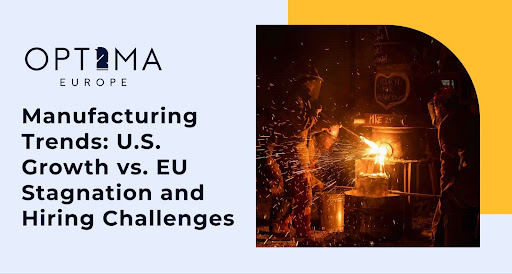
Trends im verarbeitenden Gewerbe: Wachstum in den USA versus Stagnation in der EU und Herausforderungen bei der Personalbeschaffung

The processing industry of the European Union (EU) and the United States (USA) is in middle point an growth economic ungleichheit. Im Zuge der Entwicklung der Weltwirtschaft werfen die gegensätzlichen Entwicklungen dieser Regionen drängende energiepolitische Fragen auf, zu den Unterschieden beim Pro-Kopf-BIP und ihren kaskadierenden Auswirkungen auf den Arbeitsmarkt, insbesondere bei der Rekrutierung im verarbeitenden Gewerbe.
Wirtschaftliche Divergenz: Eine immer größer werdende Lücke beim BIP pro Kopf
Seit der Finanzkrise 2008 hat die wirtschaftliche Ungleichheit zwischen der EU und den USA zugelegt. Im Jahr 2023 meldeten die USA ein BIP pro Kopf in Kaufkraftparität (PPP) von etwa 80,035$, verglichen mit 53,960$ in der EU — ein Unterschied von fast 50%. Diese Lücke betont das stärkere Wirtschaftswachstum und die höhere Produktivität in den USA, die auf robuste private Investitionen, Innovationen und politische Unterstützung für Schlüsselindustrien zurückzuführen sind.
Im Gegensatz dazu schränkt die Stagnation in vielen Volkswirtschaften der EU ein, die durch hohe Energiekosten und ein starkes regulatorisches Umfeld noch verschärft wird, ihre Wettbewerbsfähigkeit auf globaler Ebene. This ungleichheit spiegelt sich wider auf dem Arbeitsmarkt weiter, wo das verarbeitende Gewerbe in den USA besser positioniert ist, um Talente mit höheren Löhnen und besseren Aufstiegschancen anzuziehen.
Energy costs and political challenges in the EU
Energie ist ein wichtiger Faktor für die Wettbewerbsfähigkeit der verarbeitenden Industrie, und die Abhängigkeit der EU von verflüssigtem Erdgas (LNG) verdeutlicht ihre Herausforderungen. Angesichts der geopolitischen Spannungen mit Russland sprach die Präsidentin der Europäischen Kommission, Ursula von der Leyen, für erhöhte LNG-Importe aus den USA. LNG aus den USA kostet jedoch bis zu viermal mehr als russisches Pipeline-Gas, was Energy for European Manufacturers zu einer hohen Belastung macht.
Im Jahr 2023 gaben 10% der Haushalte in der EU an, dass sie keine angemessene Heizung leisten können, was die wirtschaftliche Belastung sowohl für Verbraucher als auch für Unternehmen hervorhebte. Höhere Energiekosten reduzieren die Fähigkeit europäischer Unternehmen, ihre Produktion auszuweiten, in neue Technologien zu investieren und qualifizierte Arbeitskräfte einzustellen.
Publishing of Production: Ein transatlantischer Wandel
Angesichts steigender Energiekosten und verschärfter regulatorischer Beschränkungen verlagern viele Hersteller in der EU ihre Produktion in Regionen mit geringen Kosten, darunter die USA. The United States benefit of an flexible regulation area and reichlichen inländischen Energieressourcen, was sie als attraktives Ziel für Investitionen in die Produktion positionierte.
Bei der Rekrutierung führt dieser Wandel zu zwei gegensätzlichen Realitäten:
- In der EU: In energieintensiven Branchen wie der Chemie- und Schwerindustrie könnte die Nachfrage nach Talenten sinken. The recruiting efforts could focus more on roles, support the energy change, as also engineers for green technologies and sustainability analysts.
- In den Vereinigten Staaten: The verlagering by in the EU based manufacturers curbelt the request by a range of roles an, including production workers, supply chain manager and automation specialists.
Rekrutierungstrends and future effects
The transatlantic economic kluft determined the future of recruitment in multiple view:
- Bessere Chancen in den Vereinigten Staaten: The processing industry in the United States will only to meaning, if it goes a progressive technology, including applications in the areas Robotics, artificial intelligence (KI) and Internet of things (IoT).
- Die Rollen der Energiewende in der EU: The EU agenda for an greenchange opens opportunities in the areas erneuerbarer Energien, energiespeicherung und CO2-Abscheidung. The request to talents is they will be verlagern by traditional activities in the production industry into positions, the special ability in the areas sustainability and clean energy requires.
- Weltweite Mobilität von Talenten: The company verlagern their production, it can come to a approach of the grenzüberschreitend recruitment, the workers between the regions in and here to get the stellenangebote.
The work market is to adjust to these changes, with the focus on umschool and further education, to be gerecht to the these abzeichnenden requirements. Die politischen Entscheidungsträger in der EU und den USA müssen zusammenarbeiten, um die tatsächliche Ursache dieser Ungleichheiten zu bekämpfen und die Chancengleichheit der Arbeitnehmer und ein nachhaltiges Wachstum der Unternehmen zu gewährleisten.
The production gefälle between the EU and the USA is not only an economic challenge, but also a weckruf for the future of work. Angesichts der Weiterentwicklung der Rekrutierungslandschaft sind Agilität, Anpassungsfähigkeit und die Konzentration auf zukunftsfähige Fähigkeiten entscheidend, um diese Veränderungen effektiv zu bewältigen.

